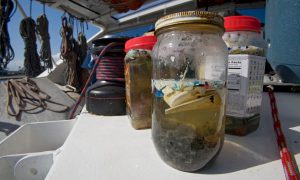The origin point and reasoning for human warfare is widely debated. Yet, an answer would provide valuable information that could help humans cease or prevent wars. Warfare is said to be common after state societies emerged 5,000 years ago. This does not mean that there aren’t accounts outside of those descriptors, though. At one sight in Kenya, evidence of warfare was dated to 10,000 years ago. This site combats the generalization of warfare’s origin story.
In 2012, at a site in Nataruk, west of Kenya’s lake Turkana, researchers discovered a large number of battered skeletons. The skeletons were widely spread out. The remains seem to be of a small hunter-gatherer band who lived approximately 9,500 to 10,500 years ago. The remains and surrounding sources were dated using radiocarbon dating, optically stimulated luminescence, and uranium series.
There were 27 skeletons at a minimum. All 27 of them were not buried. The remains comprised of six children and 21 adults. Trauma was found on the crania, cheekbones, hands, knees, ribs, and neck, to name a few (Handwerk 2016). There is also evidence of bound wrists on four skeletons. These locations of trauma are the most commonly targeted in violence cases. The weapons used to create all of these lesions were projectile points, a club-like weapon, and another weapon to be held at close proximity. This knowledge implies that the people had undergone violent deaths.

(Figure 2. Distribution of finds at Nataruk. Graphic by Esri, DigitalGlobe, GeoEye, i-cubed, USDA, USGS, AEX, Getmapping, Aerogrid, IGN, IGP, swisstopo, and the GIS User Community)
Usually conflict arises in sedentary societies. Since sedentary societies control land and resources, is believed that the “root causes for most warfare was control of resources… Including food, labor, and raw materials” (Sabloff 67). This, however, is not true at the site in Nataruk. The projectile points show inter-group conflict (Lahr 2016) and the rest of the weapons show that the hunter-gatherer group was victim to a premeditated attack. This shows that the group had valuable resources, even though it wasn’t a state society.
This begs the question, “what valuable resources did they have?” Evidence shows that West Turkana was a fertile landscape. The hunter-gatherer group found could have been raided for this fertile territory. They also could have raided for their women or children (Lahr 2016). There was some political complexity between the attackers and the attacked that led to this act of aggression. This exemplifies that raiding for resources is not only inherent in state societies, but foraging societies as well.
Since the Nataruk site shows us that warfare was evident in prehistory, we can conclude that warfare has existed for much longer than we assumed. Warfare seems to be a recurring phenomenon in human history and prehistory. If we study the past examples of warfare like the one at Nataruk, we may gain knowledge helpful in preventing or stopping war.
Further Reading:
http://www.pnas.org/content/112/36/11217 (Another study showing prehistoric warfare, in Central Europe)
http://science.sciencemag.org/content/341/6143/270 (Warfare in mobile hunter-gatherer bands and the implications on warfare origins)
Reference List:
Handwerk, Brian
2016, An Ancient, Brutal Massacre May Be the Earliest Evidence of War. Smithsonian.com. D.C., Washington. Accessed 10 November 2018.
Lahr, Mirazon M.
2016, Inter-group violence among early Holocene hunter-gatherers of West Turkana, Kenya. Nature, International Journal of Science. 529, pages 394–398. Accessed 10 November 2018.
Sabloff, Jeremy A.
2008 Archaeology Matters: Action Archaeology in the Modern World. Left Coast Press. Walnut Creek, California.
Images:
https://www.nature.com/articles/nature16477/figures/4
https://en.wikipedia.org/wiki/Nataruk#/media/File:2._Excavations_at_NATARUK.jpg



